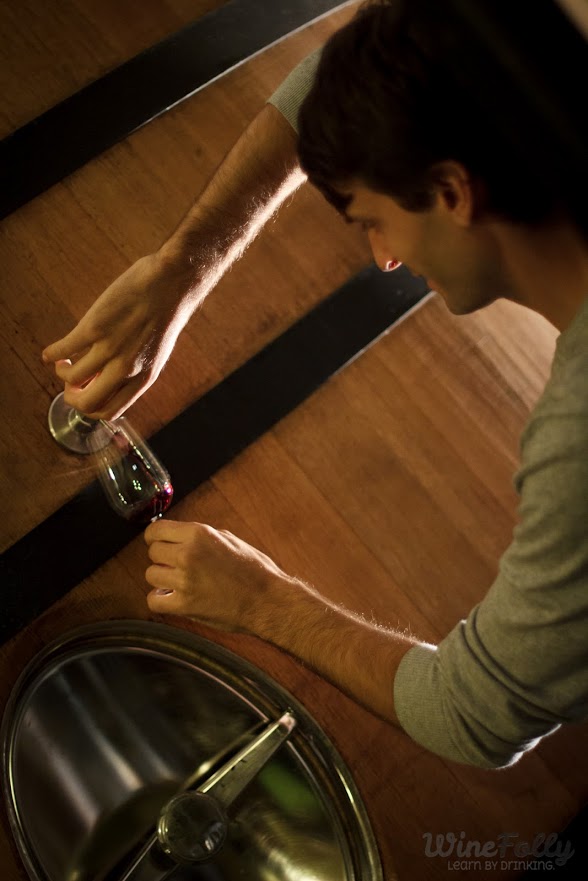Micro History of Port Wine
The people of Portugal have been growing grapes along the Douro River since the time of Jesus. The wines of the region were officially demarcated in 1756. While the term demarcation sounds confusing, it basically means the quality of Port wine is protected. Port became wildly popular when English merchants started adding brandy to preserve the wine for export.

There are 2 major factors that make Port wine unique:
- a.) Port is a sweet red wine this seems rudimentary, but it’s actually very rare.
- b.) Port has added spirits (77% ABV brandy) to stabilize the wine for long term aging.
How Port is Made
While there are many newer methods to make Port wine, we’ll be discussing the classic method of making Port wine. This method includes the use of lagars which are shallow open vats used to crush the grapes and intensify the extraction of color from the grape skins. The use of lagars is an ancient method that is rarely used anywhere else in the world.
While all Port wines start out in the same manner, each style (ie Tawny vs Ruby) have different aging methods.

Picking is Still Done By Hand
Over the last 2000 years, most of the Port winemaking process has been mechanized: from automated lagars to destemming grapes. The one thing that machines can’t do is pick the grapes. The ancient terraces are protected by UNESCO and are too narrow for tractors.
Even though there are many unique grape varietals in the Douro, most are picked together, destemmed together and fermented together. The only thing that really matters is that they are picked at the right moment.
Before it was fashionable, Portuguese wine cellars had to use gravity to make wine. It was the only way to transfer crushed juice from the lagars into barrels.
Crushing Grapes in a Lagar
The wine grapes go into lagars where they are crushed. Lagars are wide, open-top wine fermenting tanks made from stone or neutral concrete. In the Douro, lagars are made of granite.
The process of crushing the grapes is either by mechanization or foot treading. This process takes up to 3 days and then the wine is transferred into fermentation tanks where they continue to ferment until the optimal sugar level is reached. The measure of sugar level is called Baumé.
Adding Brandy To Make Port
Port wine doesn’t go through a complete fermentation. Instead, the fermentation is stopped when the ideal sugar level is reached.
The addition of spirits stops the fermentation by creating an environment where the wine yeasts can’t survive. Winemakers add the brandy evenly into the Port wine so the yeasts “go to sleep” calmly. Most Port producers use about 30% brandy to reach the legal minimum of 17.5 ABV.
Did you know? Almost all of the brandy used in Portugal is imported from South Africa.

Aging Port Wines
Port is stable after the brandy is added but it still needs time to develop. Legally, all Port wines must be aged for a minimum of 2 years before release. Even then, it’s illegal for a Port producer to sell more than 30% of their vintage. This means that Port wine producers are legally “encouraged” to age their wines for extended periods of time. Crazy.
Age Port in Large Oak “Balseiros” or Small Oak “Pipas”?
Aging Port in large oak balseiros or steel containers maintains the initial winey (or ‘vinus’) flavor of Port. Aging in smaller oak barrels called ‘pipas’ makes Port taste more nutty. The Pipas do this by increasing the amount of oxygen exposure to the wine. Winemakers rotate their wines to achieve their ideal balance of character.

Tawny ports all typically go through longer periods aging in pipas.
List of Port Styles
After visiting the IVDP in Portugal we realized that guaranteeing all the Port in the world is not an easy task. The styles of Port are a bit more nebulous than you’d think.
For instance, if a producer doesn’t release their wine in time to be a Vintage Port, then that same wine will get released as a Late Bottled Vintage (LBV). LBVs are considered a lower-valued product, even though that’s not always the case.
- Vintage Port Single vintage aged for 2 years in barrel. Bottled. Meant to age for 10-50 years in bottle.
- Late Bottled Vintage Port Single vintage aged for 4-6 years in barrel. Bottled. Usually meant to drink young, although some are as long lived as Vintage.
- Tawny Port Multiple vintages aged for 3 years in barrels, but usually 10-40+ years. Bottled. Meant to be drunk soon after bottling.
- Colheita Port Single vintage aged for many years in barrels. Bottled. Meant to be drunk soon after bottling
- White Port Same as other ports, but made with white grapes.
- Rose Port Same as other ports, but made in a rosé style.
- Crusted Port Blended Vintage Port. Not as popular these days.
- Garrafeira I’m guessing a producer accidentally left their port outside in jars under the sun later called it “Garrafeira.” Good problem solving. I’ve never loved one…yet.
